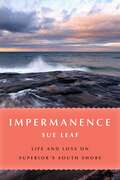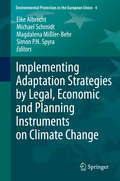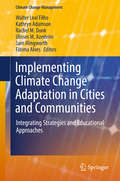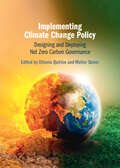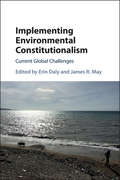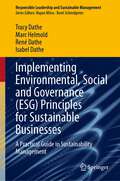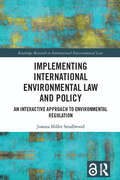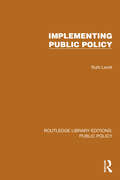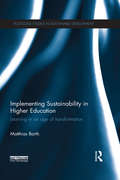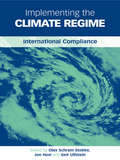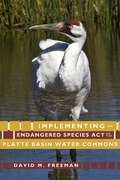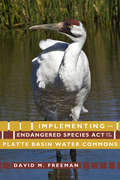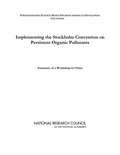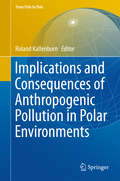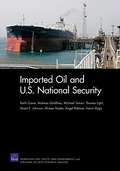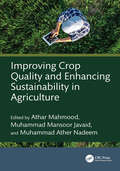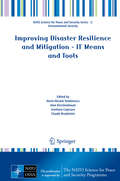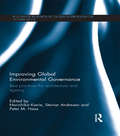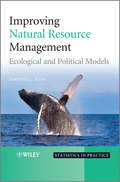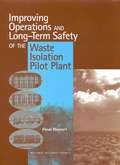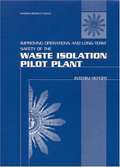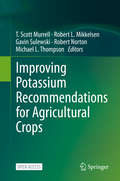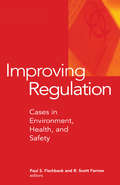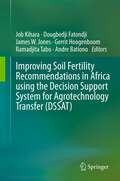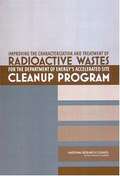- Table View
- List View
Impermanence: Life and Loss on Superior's South Shore
by Sue LeafA personal journey through the ever-changing natural and cultural history of Lake Superior&’s South Shore Lake Superior&’s South Shore is as malleable as it is enduring, its red sandstone cliffs, clay bluffs, and golden sand beaches reshaped by winds and water from season to season—and sometimes from one hour to the next. Generations of people have inhabited the South Shore, harvesting the forests and fish, mining copper, altering the land for pleasure and profit, for better or worse. In Impermanence, author Sue Leaf explores the natural and human histories that make the South Shore what it is, from the gritty port city of Superior, Wisconsin, to the shipping locks at Sault Ste. Marie, Michigan. For Leaf, what began as a bicycling adventure on the coast of Lake Superior in 1977 turned into a lifelong connection with the area, and her experience, not least as owner of a rustic cabin on a rapidly eroding lakeside cliff, imbues these essays with a passionate sense of place and an abiding curiosity about its past and precarious future. As waves slowly consume the shoreline where her family has spent countless summers, Leaf is forced to confront the complexity of loving a place that all too quickly is being reclaimed by the great lake. Impermanence is a journey through the South Shore&’s story, from the early days of the Anishinaabe and fur traders through the heyday of commercial fishing, lumber camps, and copper mining on the Keweenaw Peninsula to the awakening of the Northland to the perils and consequences of plundering its natural splendor. Noting the geological, ecological, and cultural features of each stop on her tour along the South Shore, Leaf writes about the restoration of the heavily touristed Apostle Islands National Lakeshore to its pristine conditions, even as Lake Superior maintains its allure for ice fishers, kayakers, and long-distance swimmers. She describes efforts to protect the endangered piping plover and to preserve the diverse sand dunes on the Michigan coast, and she observes the slough that supports rare intact wild rice beds central to Anishinaabe culture. Part memoir, part travelogue, part natural and cultural history, Leaf&’s love letter to Lake Superior&’s South Shore is an invitation to see this liminal world in all its seasons and guises, to appreciate its ageless, ever-changing wonders and intimate charms.
Implementing Adaptation Strategies by Legal, Economic and Planning Instruments on Climate Change
by Michael Schmidt Eike Albrecht Magdalena Mißler-Behr Simon P. N. SpyraThe causes and effects of climate change are just as varied as the proposed solutions and approaches for dealing with the problem. Given the global character of climate change, comprehensive global cooperation is called for that leads to effective and appropriate international action in accordance with the respective responsibilities. These will inevitably differ depending on the capabilities and the social and economic situations of the respective actors. The contributions in this book present a variety of ideas, approaches and tools regarding the adaptation to climate change in specific countries and regions. In addition to examining (existing) legal instruments, they also focus on the implementation of economic instruments and planning tools, as well as their (further) development. Rather than simply discussing strategies to counteract climate change by reducing emissions, the authors also search for ways of actively adapting to climate change.
Implementing Climate Change Adaptation in Cities and Communities
by Walter Leal Filho Ulisses M. Azeiteiro Fátima Alves Kathryn Adamson Rachel M. Dunk Sam IllingworthThis book analyzes how climate change adaptation can be implemented at the community, regional and national level. Featuring a variety of case studies, it illustrates strategies, initiatives and projects currently being implemented across the world. In addition to the challenges faced by communities, cities and regions seeking to cope with climate change phenomena like floods, droughts and other extreme events, the respective chapters cover topics such as the adaptive capacities of water management organizations, biodiversity conservation, and indigenous and climate change adaptation strategies. The book will appeal to a broad readership, from scholars to policymakers, interested in developing strategies for effectively addressing the impacts of climate change.
Implementing Climate Change Policy: Designing and Deploying Net Zero Carbon Governance
by Ottavio Quirico Walter BaberThe chapters in this volume provide an interdisciplinary and comparative analysis of the implementation of climate change policies worldwide to assess whether they are meeting the aims set out in the 'Paris Agreement'. The first part compares climate policies employed by the EU, the US, Latin America, Russia, China, the Middle East, and Africa. The second explores ways of improving key regulatory mechanisms to increase the effectiveness of greenhouse gas mitigation and adaptation measures. This book argues that the international community should improve the effectiveness of enforcement mechanisms from the standpoint of secondary norms through an integrated approach. It is an indispensable resource for undergraduate and graduate students of environmental policy and governance, public policy, law and political science, as well as policy makers. This title is part of the Flip it Open Programme and may also be available as Open Access. Check our website - Cambridge Core - for details. (150, 992)
Implementing Environmental Constitutionalism: Current Global Challenges
by Erin Daly James R. MayConstitutions can play a central role in responding to environmental challenges, such as pollution, biodiversity loss, lack of drinking water, and climate change. The vast majority of people on earth live under constitutional systems that protect the environment or recognize environmental rights. Such environmental constitutionalism, however, falls short without effective implementation by policymakers, advocates and jurists. Implementing Environmental Constitutionalism: Current Global Challenges explains and explores this 'implementation gap'. This collection is both broad and deep. While some of the essays analyze crosscutting themes, such as climate change and the need for rule of law that affect the implementation of environmental constitutionalism throughout the world, others delve deeply into geographically contextual experiences for lessons about how constitutional environmental law might be more effectively implemented. This volume informs global conversations about whether and how environmental constitutionalism can be made more effective to protect the natural environment.
Implementing Environmental, Social and Governance: A Practical Guide in Sustainability Management (Responsible Leadership and Sustainable Management)
by Marc Helmold Tracy Dathe René Dathe Isabel DatheThe concept of environmental, social and governance (ESG) is rapidly emerging as the new global industry standard and an important benchmarking tool for socially responsible investments. Major corporations seek the expertise of specialized consultants to develop and implement tailored ESG framework for their businesses. This book offers a guide to ESG and its practical applications. Beyond introducing the structured procedures of the most common ESG approaches, it delves into the comprehensive impact on the value chain, providing practical insights. The text explores the latest trends in various business sectors, offering insights into their ESG practices. Closing with a forward-looking perspective, the book anticipates future developments such as climate change management and ESG certifications, while also addressing potential pitfalls encapsulated by the term “greenwashing”.Written by authors with a solid background in teaching and research, the book establishes a robust theoretical foundation. The inclusion of numerous practical examples and country-specific recommendations enhances this book’s applicability and makes it an invaluable resource to those navigating the complexities of ESG.
Implementing International Environmental Law and Policy: An Interactive Approach to Environmental Regulation (Routledge Research in International Environmental Law)
by Joanna Miller SmallwoodThis book introduces a novel discourse, based on socio-legal theory of compliance with international environmental law, which addresses the overarching question: When can international environmental law and policy achieve implementation, compliance, and be effective?Offering an important contribution to academic and practical understandings of implementation and compliance with international environmental obligations, the book firstly critiques existing multidisciplinary theories of law and then brings together international and domestic legal theories to highlight their symbiotic relationship. It also stresses the importance of interactions between domestic and international legal and policy processes. This pioneering discourse is argued to be transformative to international environmental regimes and offers a way for them to be truly normative and to achieve compliance.The book will be of interest to students and scholars in the field of socio-legal studies and international environmental law and policy.The Open Access version of this book, available at http://www.taylorfrancis.com, has been made available under a Creative Commons Attribution-Non Commercial-No Derivatives (CC-BY-NC-ND) 4.0 license.
Implementing Public Policy (Routledge Library Editions: Public Policy)
by Ruth LevittOriginally published in 1980, this book takes as case studies various policies arising from the Control of Pollution Act 1974 and traces their implementation and impact. The information about disposal of toxic waste on land, bathing water quality, noise abatement zones and industrial air pollution offers fruitful areas of investigation, highlighting different aspects of environmental pollution policy and its wider implications as well as illustrating vital components of the implication process, including enforcement and discretion. Many of these issues are as pertinent now as when the book was first published. Drawing on this evidence to establish some of the features central to public policy generally, the book will be of use to historians of public and environmental policy and those teaching and researching it.
Implementing Sustainability in Higher Education: Learning in an age of transformation (Routledge Studies in Sustainable Development)
by Matthias BarthIn a time of unprecedented transformation as society seeks to build a more sustainable future, education plays an increasingly central role in training key agents of change. This book asks how we can equip students and scholars with the capabilities to promote sustainability and how the higher education curriculum can be changed to facilitate the paradigm shift needed. Across the globe, a rising number of higher education institutions and academics are responding to these questions by transforming their own teaching and learning and their institutions’ curricula. This book contributes to that development by examining in-depth case studies of innovative approaches and curriculum changes at multiple levels of the education sector. Elaborating key principles of higher education for sustainable development and identifying drivers and barriers to implementing sustainability in the curriculum, the book provides a comprehensive overview of what makes higher education for sustainable development a unique field of research and practice, as well as offering a coherent narrative of how change can be effected in it. This much-needed book is a valuable resource to inform, guide and inspire students, academics, administrators and community partners, whether experienced or new to the field, whether already committed or not to higher education for sustainable development in an age of transformation.
Implementing the Climate Regime: International Compliance
by Olav Schram StokkeGlobal warming is the most severe environmental challenge faced by humanity today and the costs of responding effectively will be high. While Russia's ratification of the Kyoto Protocol ensures the treaty's entry into force, lack of capacity, or incentives to renege on their commitments, will impede mitigation efforts in many countries. An important prerequisite for the proper functioning of the Protocol is that its compliance system - which is spelled out by the Marrakesh Accords - proves effective. Implementing the Climate Regime describes and analyses Kyoto's compliance system. Organized into four parts, Part I describes the emergence and design of the compliance system, while Part II analyses various challenges to its effective operation - such as the development of norms, verification and the danger that the use of punitive 'consequences' may also hurt compliant countries. Part III discusses the potential role of external enforcement, with particular emphasis on trade sanctions. Part IV addresses the relationship between Kyoto compliance on one hand, and international governance, oil companies and green NGOs on the other.
Implementing the Endangered Species Act on the Platte Basin Water Commons
by David M. FreemanWater users of the Platte River Basin have long struggled to share this scarce commodity in the arid high plains, ultimately organizing collectively owned and managed water systems, allocating water along extensive stream systems, and integrating newer groundwater with existing surface-water uses. In 1973, the Endangered Species Act brought a new challenge: incorporating the habitat needs of four species-the whooping crane, piping plover, least tern, and pallid sturgeon-into its water-management agenda. Implementing the Endangered Species Act on the Platte Basin Water Commons tells of the negotiations among the U.S. Department of the Interior, the environmental community, and the states of Wyoming, Colorado, and Nebraska that took place from the mid-1970s to 2006. Ambitious talks among rival water users, environmentalists, state authorities, and the Department of the Interior finally resulted in the Platte River Habitat Recovery Program. Documenting how organizational interests found remedies within the conditions set by the Endangered Species Act, describing how these interests addressed habitat restoration, and advancing sociological propositions under which water providers transcended self-interest and produced an agreement benefiting the environment, this book details the messy process that took place over more than thirty years. Presenting important implications for the future of water management in arid and semi-arid environments, this book will be of interest to anyone involved in water management, as well as academics interested in the social organization of common property.
Implementing the Endangered Species Act on the Platte Basin Water Commons (G - Reference, Information And Interdisciplinary Subjects Ser.)
by David M. FreemanWater users of the Platte River Basin have long struggled to share this scarce commodity in the arid high plains, ultimately organizing collectively owned and managed water systems, allocating water along extensive stream systems, and integrating newer groundwater with existing surface-water uses. In 1973, the Endangered Species Act brought a new challenge: incorporating the habitat needs of four species-the whooping crane, piping plover, least tern, and pallid sturgeon-into its water-management agenda. Implementing the Endangered Species Act on the Platte Basin Water Commons tells of the negotiations among the U.S. Department of the Interior, the environmental community, and the states of Wyoming, Colorado, and Nebraska that took place from the mid-1970s to 2006. Ambitious talks among rival water users, environmentalists, state authorities, and the Department of the Interior finally resulted in the Platte River Habitat Recovery Program. Documenting how organizational interests found remedies within the conditions set by the Endangered Species Act, describing how these interests addressed habitat restoration, and advancing sociological propositions under which water providers transcended self-interest and produced an agreement benefiting the environment, this book details the messy process that took place over more than thirty years. Presenting important implications for the future of water management in arid and semi-arid environments, this book will be of interest to anyone involved in water management, as well as academics interested in the social organization of common property.
Implementing the Stockholm Convention on Persistent Organic Pollutants: Summary of a Workshop in China
by National Research Council of the National AcademiesThis report summarizes a workshop --- Strengthening Science-Based Decision-Making: Implementing the Stockholm Convention on Persistent Organic Pollutants held June 7-10, 2004, in Beijing, China. The presentations and discussions summarized here describe the types of scientific information necessary to make informed decisions to eliminate the production and use of Persistent Organic Pollutants (POPs) banned under the Stockholm Convention, sources of information; scientifically informed strategies for eliminating POPs, elements of good scientific advice, such as transparency, peer review, and disclosure of conflicts of interest; and information dealing with POPs that decision makers need from the scientific community, including next steps to make such science available and ensure its use on a continuing basis.
Implications and Consequences of Anthropogenic Pollution in Polar Environments
by Roland KallenbornThe first evidence on the adverse effects of organic pollutants on Arctic ecosystems was provided by international research initiatives more than 30 years ago. Today, the indigenous people of the North are considered to be affected by exposure to persistent organic pollutants (POPs) and metals through their traditional marine food sources. The occurrence of pollutants of emerging concern in remote Polar environments is considered an essential criterion for prioritising this (largely neglected) type of contamination in national, international and global regulation schemes. Initiated during the first international Polar Years (IPY 2007-2009) and continued afterwards, 11 representative initiatives and projects are summarised as chapters in this book, which highlights today's interdisciplinary research on POPs in the Polar environment. The individual chapters describe in detail the consequences, priorities and perspectives of international research on POPs (legacy and emerging xenobiotics), its implications for regulations and scientific priorities including societal and cultural developments in the Arctic, as well as conservation priorities in Antarctica. This book is intended for all readers interested in learning more about modern research on environmental pollutants in the Polar environments (with a strong focus on Arctic environments). The impacts of pollution and climate change on Polar regions and the world as a whole will continue to be felt for many years to come. Sound science is, thus, vital in order to underpin actions that need to be taken at the global, regional and local levels. This book contributes to this highly relevant, interdisciplinary environmental scientific endeavour.
Imported Oil and U.S. National Security
by Keith Crane Stuart E. Johnson Michael Toman Andreas Goldthau Thomas LightIn 2007, the United States imported 58 percent of the oil it consumed. This book critically evaluates commonly suggested links between these imports and U.S. national security and assesses the economic, political, and military costs and benefits of potential policies to alleviate imported oil?related challenges to U.S. national security.
Improving Crop Quality and Enhancing Sustainability in Agriculture
by Muhammad Mansoor Javaid Muhammad Ather NadeemAgriculture is facing unprecedented challenges due to climate change, resource depletion, and the growing global population. Improving Crop Quality and Enhancing Sustainability in Agriculture presents cutting-edge technologies and practical solutions providing information on sustainable agricultural practices. Edited by Dr. Athar Mahmood, Dr. Muhammad Mansoor Javaid, and Dr. Muhammad Ather Nadeem, the book explores sustainable approaches to improving crop quality while preserving the environment.This book delves into topics including precision farming, biotechnology, and nanotechnology, and shows how these technologies are transforming agricultural practices. It also highlights organic farming, regenerative agriculture, and eco-friendly pest control methods that offer sustainable alternatives to conventional approaches.A key focus of the book is the role of healthy soil and nutrient management in improving crop quality. It features information on advanced irrigation techniques, biofertilizers, organic soil amendments, and innovative seed treatments that help crops thrive under challenging conditions. Additionally, the book discusses sustainable fiber production and the repurposing of agricultural waste for bioethanol production, contributing to a more circular agricultural economy.As the agricultural landscape evolves, Improving Crop Quality and Enhancing Sustainability in Agriculture emphasizes the importance of climate-smart farming methods to adapt to climate change and mitigate the impacts of extreme weather conditions such as droughts, heatwaves, and unpredictable rainfall. With contributions from leading scholars and practitioners, this book serves as a vital resource for researchers, agronomists, policymakers, and farmers who are committed to adopting sustainable solutions in their work.
Improving Disaster Resilience and Mitigation - IT Means and Tools
by Horia-Nicolai Teodorescu Alan Kirschenbaum Svetlana Cojocaru Claude BruderleinThe focus of this volume is comprised of the fundamentals, models, and information technologies (IT) methods and tools for disaster prediction and mitigation. A more detailed list of topics includes mathematical and computational modeling of processes leading to or producing disasters, modeling of disaster effects, IT means for disaster mitigation, including data mining tools, knowledge-based and expert systems for use in disaster circumstances, GIS-based systems for disaster prevention and mitigation and equipment for disaster-prone areas. A specific type or class of disasters (natural or human-made), however will not be part of the main focus of this work. Instead, this book was conceived to offer a comprehensive, integrative view on disasters, seeking to determine what various disasters have in common. Because disaster resilience and mitigation involve humans, societies and cultures, not only technologies and economic models, special attention was paid in this volume to gain a comprehensive view on these issues, as a foundation of the IT tool design.
Improving Global Environmental Governance: Best Practices for Architecture and Agency (Routledge Research in Global Environmental Governance)
by Steinar Andresen Peter M. Haas Norichika KanieThe experience of environmental governance is approached in Improving Global Environmental Governance from the unique perspective of actor configuration and embedded networks of actors, which are areas of emerging importance. The chapters look at existing Multilateral Environmental Agreements (MEAs) and the broader constellation of partially networked institutions to better understand the involvement of individual actors and how to deepen the networks that include them to generate more effective governance. The book covers a wide range of issued pertaining to environmental governance including trans-boundary air pollution, marine pollution, biodiversity and ozone depletion. It also examines partnerships as a hybrid case of emerging modes of environmental governance. These partnerships are a recent form of actor configuration that warrant attention for dealing with global environmental threats in order to better understand the full potential of actor configurations in the absence of state involvement. In order to test applicability to on-going but stalled processes, the book applies the approach to one of the most difficult issues we face: climate change. By addressing key questions in this important area, the book provides new perspectives in the nexus between agency and architecture in environmental governance in the twenty-first century.
Improving Natural Resource Management
by Timothy C. HaasThe decision to implement environmental protection options is a political one. These, and other political and social decisions affect the balance of the ecosystem and how the point of equilibrium desired is to be reached. This book develops a stochastic, temporal model of how political processes influence and are influenced by ecosystem processes and looks at how to find the most politically feasible plan for managing an at-risk ecosystem. Finding such a plan is accomplished by first fitting a mechanistic political and ecological model to a data set composed of observations on both political actions that impact an ecosystem and variables that describe the ecosystem. The parameters of this fitted model are perturbed just enough to cause human behaviour to change so that desired ecosystem states occur. This perturbed model gives the ecosystem management plan needed to reach desired ecosystem states. To construct such a set of interacting models, topics from political science, ecology, probability, and statistics are developed and explored.Key features:Explores politically feasible ways to manage at-risk ecosystems.Gives agent-based models of how social groups affect ecosystems through time.Demonstrates how to fit models of population dynamics to mixtures of wildlife data.Presents statistical methods for fitting models of group behaviour to political action data.Supported by an accompanying website featuring datasets and JAVA code.This book will be useful to managers and analysts working in organizations charged with finding practical ways to sustain biodiversity or the physical environment. Furthermore this book also provides a political roadmap to help lawmakers and administrators improve institutional environmental management decision making.
Improving Operations AND Long-Term Safety OF THE Waste Isolation Pilot Plant: Final Report
by National Research CouncilThe National Academies Press (NAP)--publisher for the National Academies--publishes more than 200 books a year offering the most authoritative views, definitive information, and groundbreaking recommendations on a wide range of topics in science, engineering, and health. Our books are unique in that they are authored by the nation's leading experts in every scientific field.
Improving Operations And Long-term Safety Of The: Interim Report
by Committee on the Waste Isolation Pilot PlantThe National Academies Press (NAP)--publisher for the National Academies--publishes more than 200 books a year offering the most authoritative views, definitive information, and groundbreaking recommendations on a wide range of topics in science, engineering, and health. Our books are unique in that they are authored by the nation's leading experts in every scientific field.
Improving Potassium Recommendations for Agricultural Crops
by Michael L. Thompson Robert Norton T. Scott Murrell Robert L. Mikkelsen Gavin SulewskiThis open access book highlights concepts discussed at two international conferences that brought together world-renowned scientists to advance the science of potassium (K) recommendations for crops. There was general agreement that the potassium recommendations currently in general use are oversimplified, outdated, and jeopardize soil, plant, and human health. Accordingly, this book puts forward a significantly expanded K cycle that more accurately depicts K inputs, losses and transformations in soils. This new cycle serves as both the conceptual basis for the scientific discussions in this book and a framework upon which to build future improvements. Previously used approaches are critically reviewed and assessed, not only for their relevance to future enhancements, but also for their use as metrics of sustainability. An initial effort is made to link K nutrition in crops and K nutrition in humans. The book offers an invaluable asset for graduate students, educators, industry scientists, data scientists, and advanced agronomists.
Improving Regulation: Cases in Environment, Health, and Safety (Rff Press Ser.)
by Paul S. Fischbeck R. Scott FarrowIs there potential for a U.S. regulatory system that is more efficient and effective? Or is the future likely to involve 'paralysis by analysis'? Improving Regulation considers the challenges faced by the regulatory system as society and technology change, and our knowledge about the effects of our activities on human and planetary health becomes more sophisticated. While considering the difficulty in linking regulatory design and performance, Improving Regulation makes the case for empowering regulatory analysis. Studying applications as diverse as fire protection, air and water pollution, and genetics, its contributors examine the strategies of different stakeholders in today's complex policymaking environment. With a focus on the behavior of institutions and people, they consider the impact that organizational politics, science, technology, and performance have on regulation. They explore the role of technology in creating and reducing uncertainty, the costs of control, the potential involvement of previously unregulated sectors, and the contentious public debates about fairness and participation in regulatory policy. Arguing that the success of many regulations depends upon their acceptance by the public, Fischbeck, Farrow, and their contributors offer extensive, inductive evidence on the art of regulatory analysis. The resulting book provides 'real world' examples of regulation, and a demonstration of how to synthesize analytical skills with a knowledge of physical and social processes.
Improving Soil Fertility Recommendations in Africa using the Decision Support System for Agrotechnology Transfer (DSSAT)
by Andre Bationo Job Kihara Gerrit Hoogenboom Ramadjita Tabo Dougbedji Fatondji James W JonesThe book gives a detailed description of the application of DSSAT in simulating crop and soil processes within various Agro-ecological zones in Africa. The book, an output of a series of 3 workshops, provides examples of the application of DSSAT models to simulate nitrogen applications, soil and water conservation practices including effects of zai technology, phosphorus and maize productivity, generation of genetic coefficients, long-term soil fertility management technologies in the drylands, microdosing, optimization of nitrogen x germplasms x water, spatial analysis of water and nutrient use efficiencies and, tradeoff analysis. The minimum dataset requirements for DSSAT is discussed. This book arises from attempts to address the limited use of models in decision support by African agricultural (both soil scientist and agronomists) scientists.
Improving The Characterization And Treatment Of Radioactive Wastes For The Department Of Energy's Accelerated Site Cleanup Program
by National Research Council of the National AcademiesThe Department of Energy’s Office of Environmental Management (EM) directs the massive cleanup of more than 100 sites that were involved in the production of nuclear weapons materials during the Manhattan Project and the Cold War. This report offers suggestions for more effectively characterizing and treating the orphan and special-case wastes that are part of EM’s accelerated cleanup program. It identifies technical opportunities for EM to improve the program that will save time and money without compromising health and safety. The opportunities identified include: making more effective use of existing facilities and capabilities for waste characterization, treatment, or disposal; eliminating self-imposed requirements that have no clear technical or safety basis; and investing in new technologies to improve existing treatment and characterization capabilities. For example, the report suggests that EM work with DOE classification officers to declassify, to the extent possible, classified materials declared as wastes. The report also suggests a new approach for treating the wastes that EM will leave in place after cleanup.
